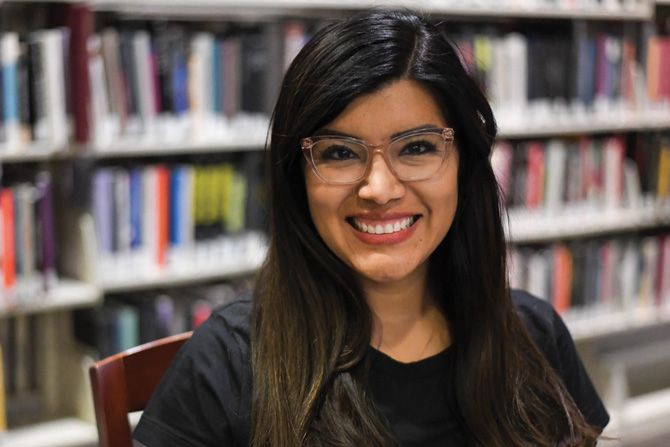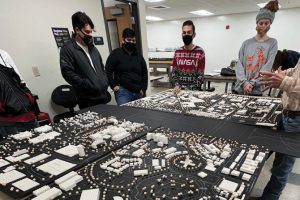Deysi’s educational path started in Lima, Peru. She transferred to TMCC and received an associate’s degree in architecture. Afterward, she transferred to the School of Architecture and Design in San Diego. While there, she received a Bachelor of Architecture, and two years later, she received a Master in Science – Sustainability in Design at Jefferson University in Philadelphia, PA.
Tell us about yourself.
My name is Deysi Montes; I am the lead faculty in architecture school here at TMCC. I am a creative designer, passionate professor, and advocate for education. I was born and raised in Peru and moved to the U.S. to pursue my education more than a decade ago. I have lived in Reno, San Diego, and Austin. So far, architecture has been an incredible experience that I get to enjoy every day.
Why did you go into the architectural field?
I basically fell into architecture school. After initially going to college for a few years for foreign languages, I went to a conference spoken only in Portuguese about fractals and architecture. Once there at the conference, I fell in love the nature’s geometrical shapes, lines, planes, and polyhedrons and was intrigued by Euclidean geometry. After that conference, I started researching these concepts and how they are represented in the built environment. I knew then that I had to change majors, so I did.
What makes the architectural program at TMCC stand out?
One of the things that make our program stand out is the accessibility and affordability. Architecture schools can and should be started at a community college that is affordable and with a transferable program. TMCC offers an opportunity to the community where students from diverse socioeconomic backgrounds first have access to quality education; and second, they can quickly transfer to third year to pursue a five-year bachelor’s degree in Architecture. I think this is a gap in the educational system throughout the U.S., where it becomes tremendously complicated and expensive to transfer from a two-year degree in architecture to a five-year program in a university. TMCC makes this process seamless and affordable for our Northern Nevada community.
Why academics in architecture rather than just plain architecture?
Academia is a noble professional path where I get to interact with people and impact the future of several students. Architecture is a generalist field, and constant research and practice are required in the field job and classroom. So in that sense, bringing current knowledge about sustainability, design, and code keeps me current on what is the latest in this profession. I teach at TMCC full-time and work independently on projects and consultancy whenever I can, and I enjoy both aspects.
What in architecture has changed the most from when you began to now?
The technology part is always evolving, so in that aspect, architecture has evolved to adapt and incorporate all these new technologies with things such as 3D printing, digital sketchbooks, smart technology, energy modeling, virtual reality modeling, and technological solutions to grid power, among several others. Although technology makes architecture evolve every time, a simple classical concept such as durability, utility, and beauty coined by Vitruvius is still relevant with modern added concepts such as resilience and adaptability.
From your first year teaching to now, how have the students changed?
COVID-19 has been a game-changer in classrooms. Students are used to interacting with computers and submitting assignments online. But this year, as the country has reopened, students have to transition again to more interactive and face-to-face learning. That benefits them as the connections and emotions facilitate information retrieval and long-term retention.
What is your favorite architectural style? Why?
My favorite architectural style is Bauhaus architecture. I enjoy the simplicity of it, its clean lines, its high functionality, and to a degree, the minimalism of this style. Bauhaus shows materials at their most natural is one of the things I enjoy the most about this style.
Who inspired you? How?
My inspiration has always been my family. I come from a family that has been resilient and united against adversity. They taught me consistency, adaptability, and hard work always pays off, a concept I have embedded in every aspect of my life.
Select a favorite teaching experience and explain why you selected it.
My favorite memory in teaching will always be by the end of the semester when students can compare the first day’s work with their last day of the semester’s work. Seeing their faces and the happiness they show when they realize their learning curve and how much they have grown is rewarding.
If you and your students were to design a building, what type of building would it be?
Usually, the first and second years will focus on residential design, and the third year program will from into commercial, office, institutional, and urban design projects.
Select (in your mind) your favorite building. Now, describe it to a sightless person.
Alhambra complex is a group of beautifully preserved buildings that show medieval Moorish architecture. Alhambra shows the example of Arabic architecture as the Arabic-Berber army crossed the strait of Gibraltar and conquered the southern Iberian Peninsula in the year 711. They stayed in Spain for almost 800 years. Additionally, Alhambra shows the adaptability and resilience of architecture because, in this complex, the architects were able to create a new style with Islamic architecture and traditions and merge them with Catholicism. When the Catholic monarchs expelled Muslims from the kingdom of Granada, they did not tear Alhambra but preserved it because of the beauty of the architecture and gardens, which is how we get to explore it now. So, Andalucia has several examples of Moorish architecture. Not only that, but the Moorish influence is seen in the food, language, and culture in general. For me, this is so interesting because soon after the conquest of the Americas started, Spaniards brought these Moorish traditions into Latin American cultures. In architecture, we can see it in the Moorish balconies all over the city of kings Lima, Peru. But really, it is everywhere; for example, the modern Spanish language has about 4000 Arabic words that are used in everyday communication one of those words is often said is “ojalá” which means to hope for a positive outcome regardless of the circumstances and this word comes from the Arabic word “inshallah” which translates to “if God wills.” I don’t want to derail too much from the original question, but for me, Alhambra is the reminder that cultures feed and influence each other regardless of distance and time and that we, as spectators, can learn about that everywhere within the built environment, architecture.
If you could go back in time – to anywhere in history in the world to see a building – where/when/which building would it be? Would you want to change it in any way?
I would love to see the Alhambra construction in Granada, Spain. This complex dates from the 9th century. I would change the fact that there were no female architects. How has teaching made you a better architect?
There are a lot of advantages of the influence of teaching can be applied to practice. One of them is that you stay current in knowledge applied to the field and the technological aspect of it.
How does AIA NNs support help you to educate the architects of tomorrow?
AIANN is in contact communication with TMCC and students supporting the program. They help the students with clubs, scholarships, and support in educational aspects. They also are an essential part of our program as they help us keep the content relevant to the needs of our region.








